方案详情文
智能文字提取功能测试中
发酵罐在大肠杆菌培养中的应用大肠杆菌是基因工程中常用的宿主菌,许多有价值的多肽和蛋白在大肠杆菌中已成功地进行了表达,表达水平有些高达细胞总蛋白的30%以上,大肠杆菌作为外源基因表达的宿主,由于具有遗传背景清楚、目的基因表达水平高,技术操作、培养条件简单,抗污染能力强,大规模发酵经济等优点,倍受遗传工程专家重视,是目前应用最广泛,最成功的表达体系。Fermenter System for E. coli culture.The fermenter is supplied in a configuration to provide an excellent bioreactor for this purpose. * Powerful, top drive system with lubricated mechanical seal (magnetic options for Techfors) * Jacketed system for efficient heat transfer. * High-accuracy pumps for addition of pH control reagents, antifoam and feed (option on some units) * Control of dissolved oxygen by stirrer speed as standard (air flow, pressure & oxygen, supplement options) * Optional analogue feed pump for variable speed additon * Analogue input/output for addition of external pumpsand sensros for eg. OD Vessels: All vessels are stainless steel (1.4435) with a dished base and top plate in several standard sizes. Temperature control can be by water circulation with either a heating element or steam injection into a pocket/exchanger.All vessels are with a mechanical seal drive (magnetic coupling for cells). The drive shaft has a simple and secure connection for the motor. The top plate is equipped with 10mm, PG13.5 and standard, rounded -thread 19mm ports which can be fitted with a septum and retaining collar to allow flaming of the port during inoculation etc. (number and type varies according to specific fermenter). Bottom ports are 25mm Ingold standard and numbers vary by size.The vessels are sterilized in situ (Techfors and Techfors S) with automatic sequencing. Reagent bottles and inlet pipes etc are usually autoclaved separately (options & alternatives, depending on size and configuration).. StirringThe fermenter has a powerful brushless motor with integral speed controller for speeds from 100 - 1500 rpm, depending on the vessel size and number of impellors. Powerful fluid cooled motors are standard for Techfors.x-DDC Control System:All fermenter models except Minifors incorporate the x-DDC (eXtended DDC microprocessor control) which uses a high-performance digital system. With the use of almost identical instrumentation, the step from Bench-scale to larger equipment is made considerably easier.The control panel is compact and is usually mounted above the base unit for clear visibility. The panel can be removed if required. Programming of parameters is via a splashproof keypad with a rotary knob for navigation and an LCD display. Communication is via a robust data-cable. For each fermenter, process information such as parameter set points, PID values etc are stored automatically on an interchangeable "memory card" . This allows changes in fermentation processes by fitting an alternative card or downloading a recipe without re-programming and the chance of errors plus an unlimited number of recipes to be stored.An "open frame" gas supply system with four magnetic valves allow addition of components for automatic mixing of gasses for oxygen supplementation. An optional mass flow control valve ensures a controlled, steady flow of gas into the vessel. Agitation & temperature control. Four high-accuracy digital peristaltic pumps supplied as standard with the option to add an integral analogue feed pump. Addition and removal of liquids is therefore possible with a standard system (using the antifoam pump for medium take-off). Accepts a conductive probe for automatic control of antifoam addition or media addition/removal in a vessel. Works together with the integral peristaltic pumps.Set points and control strategiesSet points are entered into the controller prior to inoculation and stored on a memory card (except Minifors). The vessel was allowed to equilibrate prior to inoculation. The pO2 actual value may stay above the set point up to (and some times after) inoculation.Temperature :30-40°C (depending on precise application and strain)pH: 6.8-7.0DO :30-50%Agitation :300 - 1000+ rpmO2 :Optional supplementation of the air stream using a magnetic valve (rotameter)PH ControlThe pH probe is calibrated prior to the autoclave cycle (refer to Instruction Manual). pH control parameters are:Base: 28% v/v ammonia waterAcid: If required, 4M H2SO4Transfer tubing: Narrow bore silicone tubing with Marprene insert, as supplied (4mm OD)Vessel inlet: 4mm fixed pipes in the vessel top platePID values: factory default setting should be used unless it is clear adjustment is needed (hunt or drift).Dissolved Oxygen (pO2) ControlThe dissolved oxygen electrode 100% is normally calibrated after the autoclave cycle (refer to Instruction Manual) but can be calibrated in air beforehand for cell culture applications. Control of pO2 can be cascaded eg rpm, airflow, gasmix. The controller automatically maintains the pO2 setpoint. The gas flow rate should be set at a fairly low rate initially eg. 0.3 vessel volumes per minute (VVM) and raised incrementally during the fermentation to 1-1.5VVM whenever the stirrer cannot maintain the correct pO2 value (usually required within an hour or so). This low gas flow rate initially is CRITICAL for some coli strains, especially if genetically modifiedFed-batch/Continuous FeedFeed pumps can be calibrated using the standard tubing to keep track of the liquid quantities entering and exiting the vessel. Either a digital pump with shot and delay dosing or an analogue, continuously-variable pump can be used for medium addition. Samples should be taken several times a day to measure glucose concentration and cell density (eg Optical Density at 600nm). Iris v5 software can be used to control nutrient addition. Fed-batch does not involve removal of liquid. Feeding can be related to dissolved oxygen concentration by using software control sequences.Foam ControlThis can be achieved by adding a small quantity of antifoam into the medium before inoculation (eg. 0.005 -0.01%) and subsequently controlled by a liquid antifoam delivered on demand into the vessel (or at regular time intervals). An antifoam probe uses conductivity to detect the presence of foam. The clear sheathing around the probe should not be damaged or false positive readings will occur. Suitable antifoams are available from a number of companies, including Sigma. Eg A240.Example methodologyMediumLB medium plus glucose and other supplements. A suitable strain for test purposes would be K12 as it is readily available from commercial suppliers. Use of antifoam in the medium can help suppress foaming. Supplements are filter sterilized and added after sterilization of the bulk medium in the vessel (10% loss of volume is typically experienced during the sterilization process; allow for this). InoculumPrepared in an Infors shaker (Minitron or Multitron) from an overnight culture of a few colonies picked from an agar plate and inoculated into in 250ml shake flasks containing 50ml of medium. Shaker speed is 200rpm and a temperature 30oC. Use one of these to inoculate the fermenter for every 950ml of complete medium i.e. 5% inoculum.MethodElectrodes should have been calibrated before autoclaving (pH and zero point pO2).• Sterilize the vessel with the basic medium. Adjust for evaporation losses, if necessary.• Allow to cool to operating conditions and then calibrate pO2 100% value. • Add any supplements then inoculate using a syringe or transfer line. Take a To sample for pH, optical density and carbon-source concentration measurement. Direct cell counts can be made and cells plated to check purity and measure viability. Dry weight values can be related to optical density readings and total/viable counts as required. Sample at eg. 1 hour intervals to follow the process. After approximately 2-3 hours strong logarithmic growth should occur with substrate depletion typically within 8 hours, unless fed-batch or continuous operation is implemented. Optical density values should increase quickly and level off when exponential growth has finished. The end of active growth may also be marked by a rise in the dissolved oxygen concentration/decrease in stirrer speed.High-density culture may need oxygen supplementation and glucose feeding. the probe should not be damaged or false positive readings will occur.发酵罐在大肠杆菌培养中的应用 大肠杆菌是基因工程中常用的宿主菌,许多有价值的多肽和蛋白在大肠杆菌中已成功地进行了表达,表达水平有些高达细胞总蛋白的30%以上,大肠杆菌作为外源基因表达的宿主,由于具有遗传背景清楚、目的基因表达水平高,技术操作、培养条件简单,抗污染能力强,大规模发酵经济等优点,倍受遗传工程专家重视,是目前应用最广泛,最成功的表达体系。Fermenter System for E. coli culture. The fermenter is supplied in a configuration to provide an excellent bioreactor forthis purpose. * Powerful, top drive system with lubricated mechanical seal (magnetic options forTechfors) * Jacketed system for efficient heat transfer. * High-accuracy pumps for addition of pH control reagents, antifoam and feed(option on some units) * Control of dissolved oxygen by stirrer speed as standard (air flow, pressure &oxygen, supplement options) * Optional analogue feed pump for variable speed additon * Analogue input/output for addition of external pumpsand sensros for eg. OD Vessels: All vessels are stainless steel (1.4435) with a dished base and top plate in severalstandard sizes. Temperature control can be by water circulation with either aheating element or steam injection into a pocket/exchanger. All vessels are with a mechanical seal drive (magnetic coupling for cells). The drive shaft has a simple and secure connection for the motor. The top plate is equippedwith 10mm, PG13.5 and standard, rounded -thread 19mm ports which can be fittedwith a septum and retaining collar to allow flaming of the port during inoculationetc. (number and type varies according to specific fermenter). Bottom ports are25mm Ingold standard and numbers vary by size. The vesselsareSsterilizedin situ (Techfors andTechfors SS) with1automaticsequencing. Reagent bottles and inlet pipes etc are usually autoclaved separately(options & alternatives, depending on size and configuration).. Stirring The fermenter has a powerful brushless motor with integral speed controller forspeeds from 100-1500 rpm, depending on the vessel size and number of impellors.Powerful fluid cooled motors are standard for Techfors. x-DDC Control System: All fermenter models except Minifors incorporate the x-DDC (eXtended DDCmicroprocessor control) which uses a high-performance digital system. With theuse of almost identical instrumentation, the step from Bench-scale to largerequipment is made considerably easier. The control panel is compact and is usually mounted above the base unit for clearvisibility. The panel can be removed if required. Programming of parameters is via asplashproof keypad with a rotary knob for navigation and an LCD display.Communication is via a robust data-cable. For each fermenter, process informationsuch as parameter set points, PID values etc are stored automatically on an interchangeable "memory card". This allows changes in fermentation processes byfitting an alternative card or downloading a recipe without re-programming andthe chance of errors plus an unlimited number of recipes to be stored. An "open frame" gas supply system with four magnetic valves allow addition ofcomponents for automatic mixing of gasses for oxygen supplementation. Anoptional mass flow control valve ensures a controlled, steady flow of gas into thevessel. Agitation & temperature control. Four high-accuracy digital peristalticpumps supplied as standard with the option to add an integral analogue feedpump. Addition and removal of liquids is therefore possible with a standard system(using the antifoam pump for medium take-off). Accepts a conductive probe forautomatic control of antifoam addition or media addition/removal in a vessel.Works together with the integral peristaltic pumps. Set points and control strategies Set points are entered into the controller prior to inoculation and stored on amemory card (except Minifors). The vessel was allowed to equilibrate prior toinoculation. The pO2 actual value may stay above the set point up to (and sometimes after) inoculation. Temperature : 30-40℃ (depending on precise application and strain) pH: 6.8-7.0 DO : 30-50% Agitation : 300-1000+rpm O2 : Optional supplementation of the air stream using a magnetic valve (rotameter) PH Control The pH probe is calibrated prior to the autoclave cycle (refer to Instruction Manual).pH control parameters are: Base: 28% v/v ammonia water Acid: If required, 4M H2SO4 Transfer tubing: Narrow bore silicone tubing with Marprene insert, as supplied(4mm OD) Vessel inlet: 4mm fixed pipes in the vessel top plate PID values: factory default setting should be used unless it is clear adjustment isneeded (hunt or drift). Dissolved Oxygen (pO2) Control The dissolved oxygen electrode 100% is normally calibrated after the autoclavecycle (refer to Instruction Manual) but can be calibrated in air beforehand for cellculture applications. Control of pO2 can be cascaded eg rpm, airflow, gasmix. Thecontroller automatically maintains the pO2 setpoint. The gas flow rate should beset at a fairly low rate initially eg. 0.3 vessel volumes per minute (VVM) and raisedincrementally during the fermentation to 1-1.5VVM whenever the stirrer cannotmaintain the correct pO2 value (usually required within an hour or so). This low gasflow rate initially is CRITICAL for some coli strains, especially if genetically modified Fed-batch/Continuous Feed Feed pumps can be calibrated using the standard tubing to keep track of the liquidquantities entering and exiting the vessel. Either a digital pump with shot and delaydosing or an analogue, continuously-variable pump can be used for mediumaddition. Samples should be taken several times a day to measure glucoseconcentration and cell density (eg Optical Density at 600nm). Iris v5 software canbe used to control nutrient addition. Fed-batch does not involve removal of liquid.Feeding can be related to dissolved oxygen concentration by using softwarecontrol sequences. Foam Control This can be achieved by adding a small quantity of antifoam into the mediumbefore inoculation (eg. 0.005 -0.01%) and subsequently controlled by a liquidantifoam delivered on demand into the vessel (or at regular time intervals). Anantifoam probe uses conductivity to detect the presence of foam. The clearsheathing around the probe should not be damaged or false positive readings willoccur. Suitable antifoams are available from a number of companies, includingSigma. Eg A240. Example methodology Medium LB medium plus glucose and other supplements. A suitable strain for test purposeswould be K12 as it is readily available from commercial suppliers. Use of antifoam inthe medium can help suppress foaming. Supplements are filter sterilized and addedafter sterilization of the bulk medium in the vessel (10% loss of volume is typically experienced during the sterilization process; allow for this). Inoculum Prepared in an Infors shaker (Minitron or Multitron) from an overnight culture of afew colonies picked from an agar plate and inoculated into in 250ml shake flaskscontaining 50ml of medium. Shaker speed is 200rpm and a temperature 30oC. Useone of these to inoculate the fermenter for every 950ml of complete medium i.e.5% inoculum. Method Electrodes should have been calibrated before autoclaving (pH and zero point pO2). ·SSterilize the vessel with the basic medium. Adjust for evaporation losses, ifnecessary. · Allow to cool to operating conditions and then calibrate pO2 100% value. · Add any supplements then inoculate using a syringe or transfer line. Take a Tosample for pH, optical density and carbon-source concentration measurement.Direct cell counts can be made and cells plated to check purity and measureviability. Dry weight values can be related to optical density readings andtotal/viable counts as required. Sample at eg. 1 hour intervals to follow theprocess. After approximately 2-3 hours strong logarithmic growth should occur withsubstrate depletion typically within 8 hours, unless fed-batch or continuousoperation is implemented. Optical density values should increase quickly and leveloff when exponential growth has finished. The end of active growth may also be marked by a rise in the dissolved oxygen concentration/decrease in stirrer speed. High-density culture may need oxygen supplementation and glucose feeding. the probe should not be damaged or false positive readings will occur.
关闭-
1/7
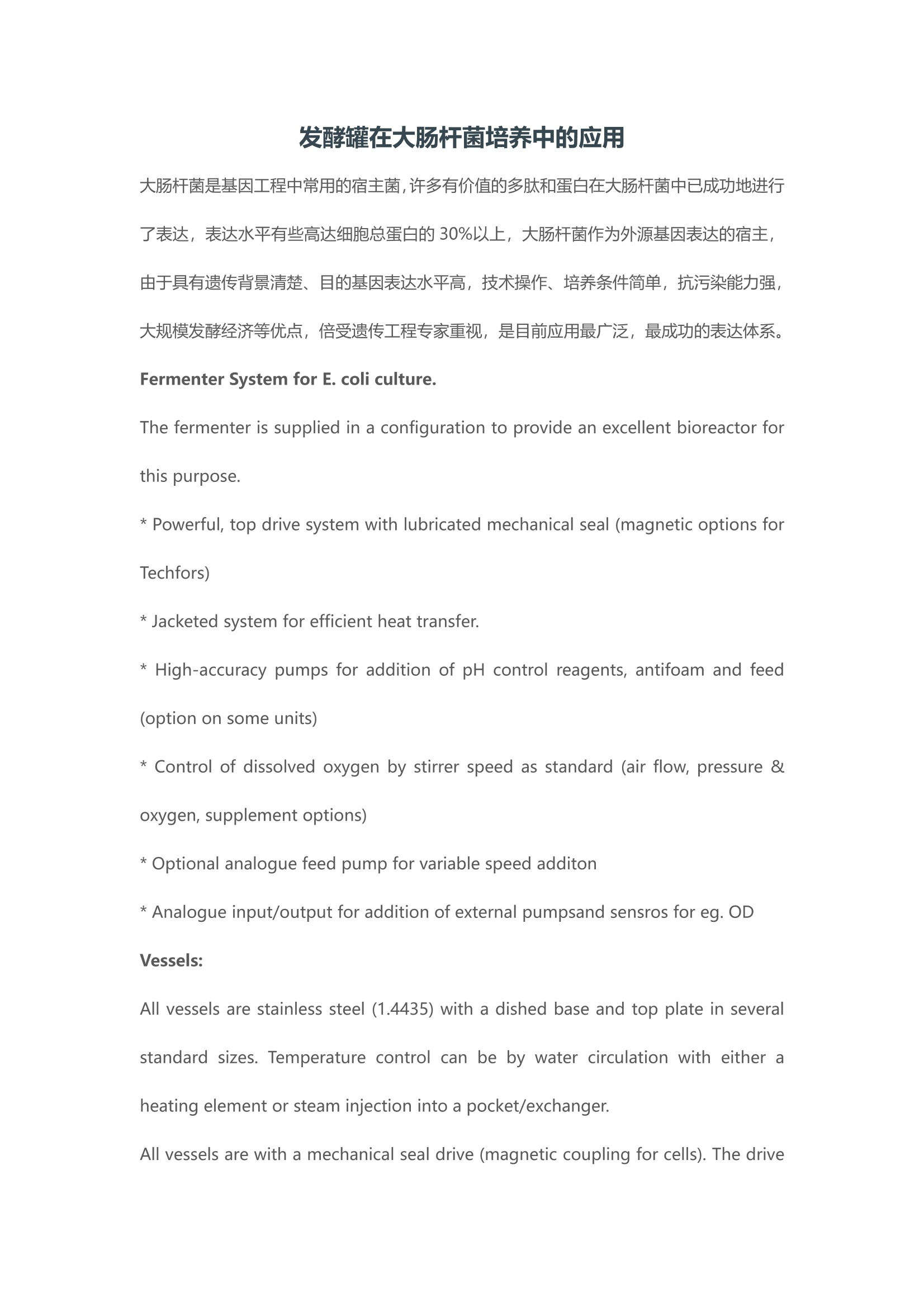
-
2/7
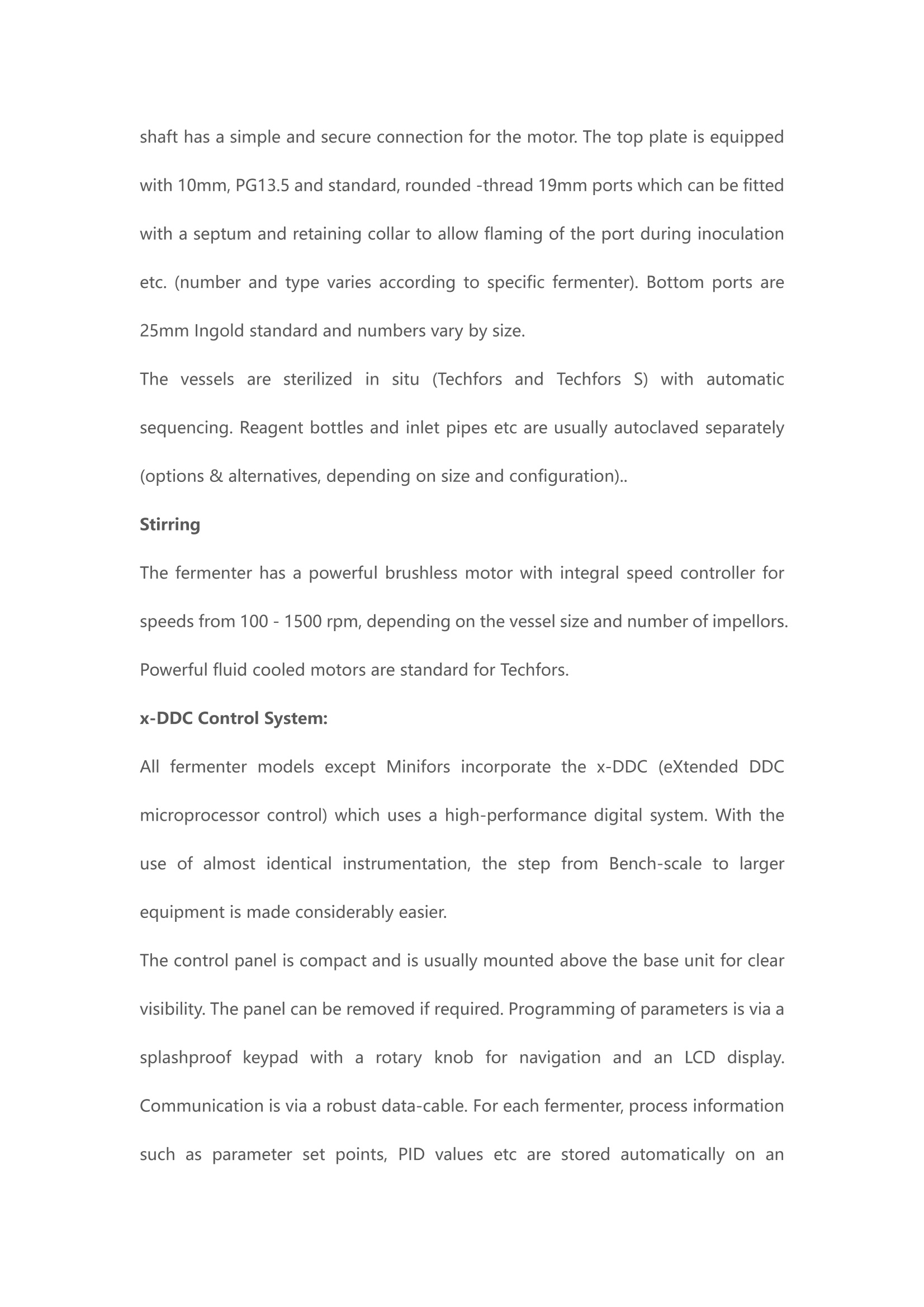
还剩5页未读,是否继续阅读?
继续免费阅读全文产品配置单
北京桑翌实验仪器研究所为您提供《发酵罐在大肠杆菌培养中的应用》,该方案主要用于生物发酵中应用介绍检测,参考标准《暂无》,《发酵罐在大肠杆菌培养中的应用》用到的仪器有INFORS Labfors Lux 平板LED光照发酵罐、INFORS Mutlitron 3mm高速振荡培养箱、INFORS Celltron CO2培养箱专用振荡器、INFORS Minifors Cell实验室台式生物反应器、INFORS Multifors平行生物反应器、INFORS Labfors 5 台式发酵罐、INFORS Minifors 实验室台式标准发酵罐。
我要纠错
推荐专场
相关方案


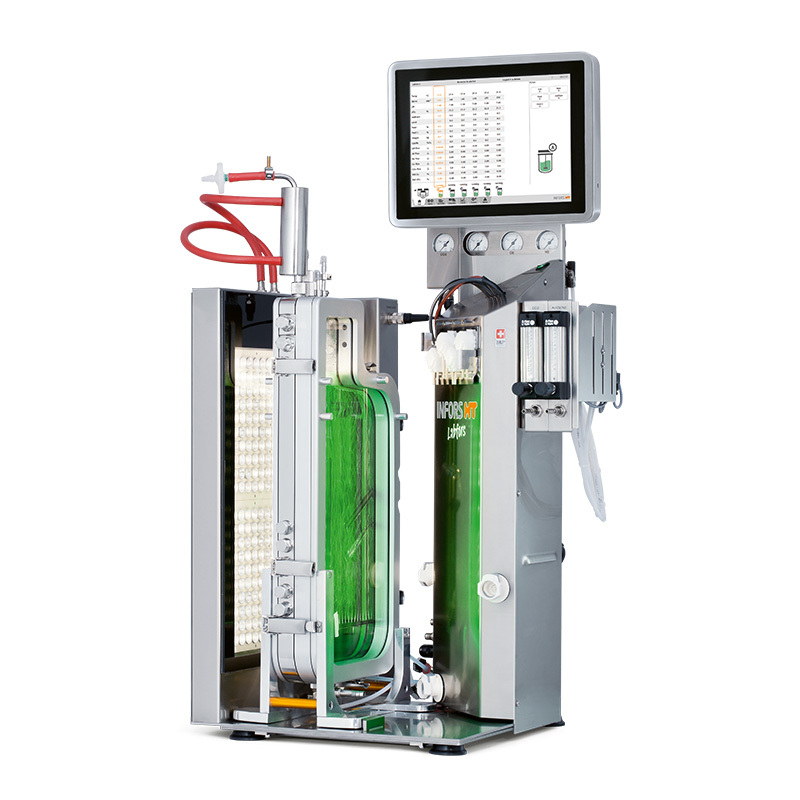
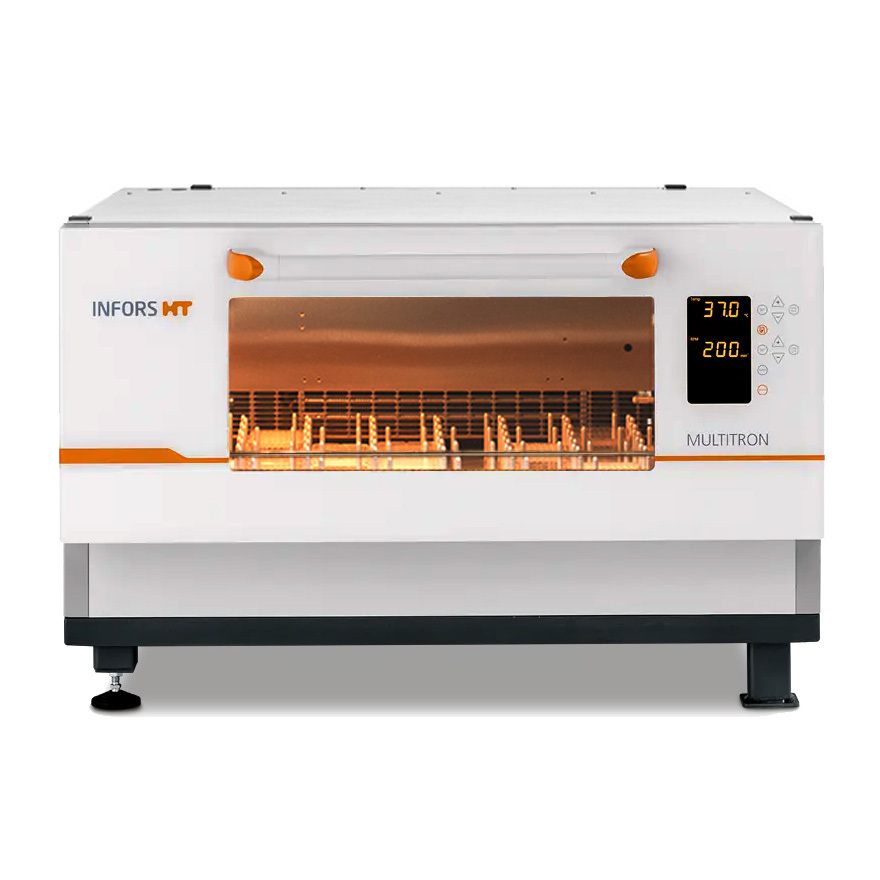
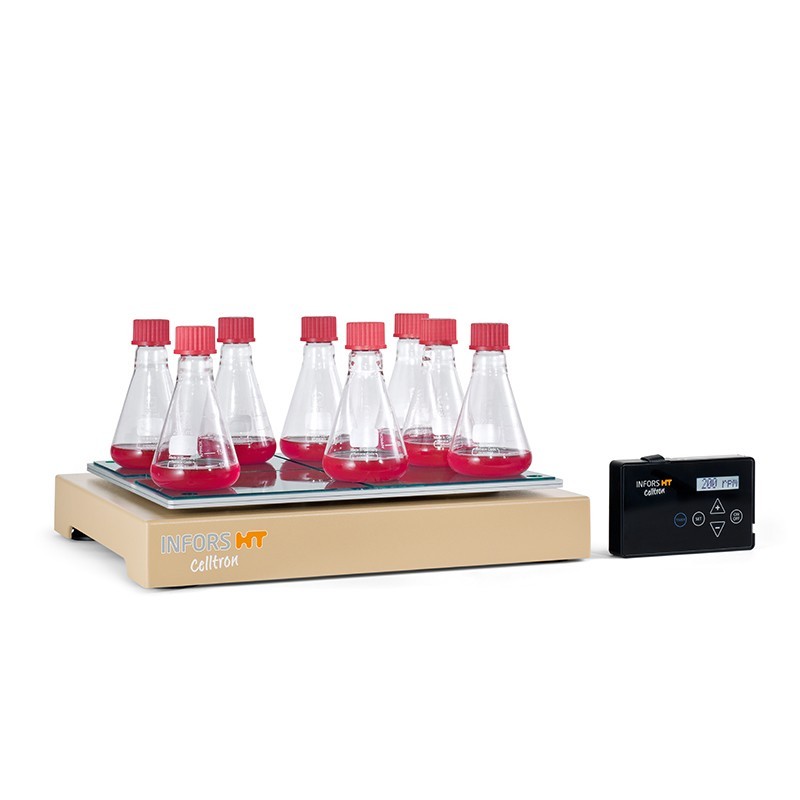
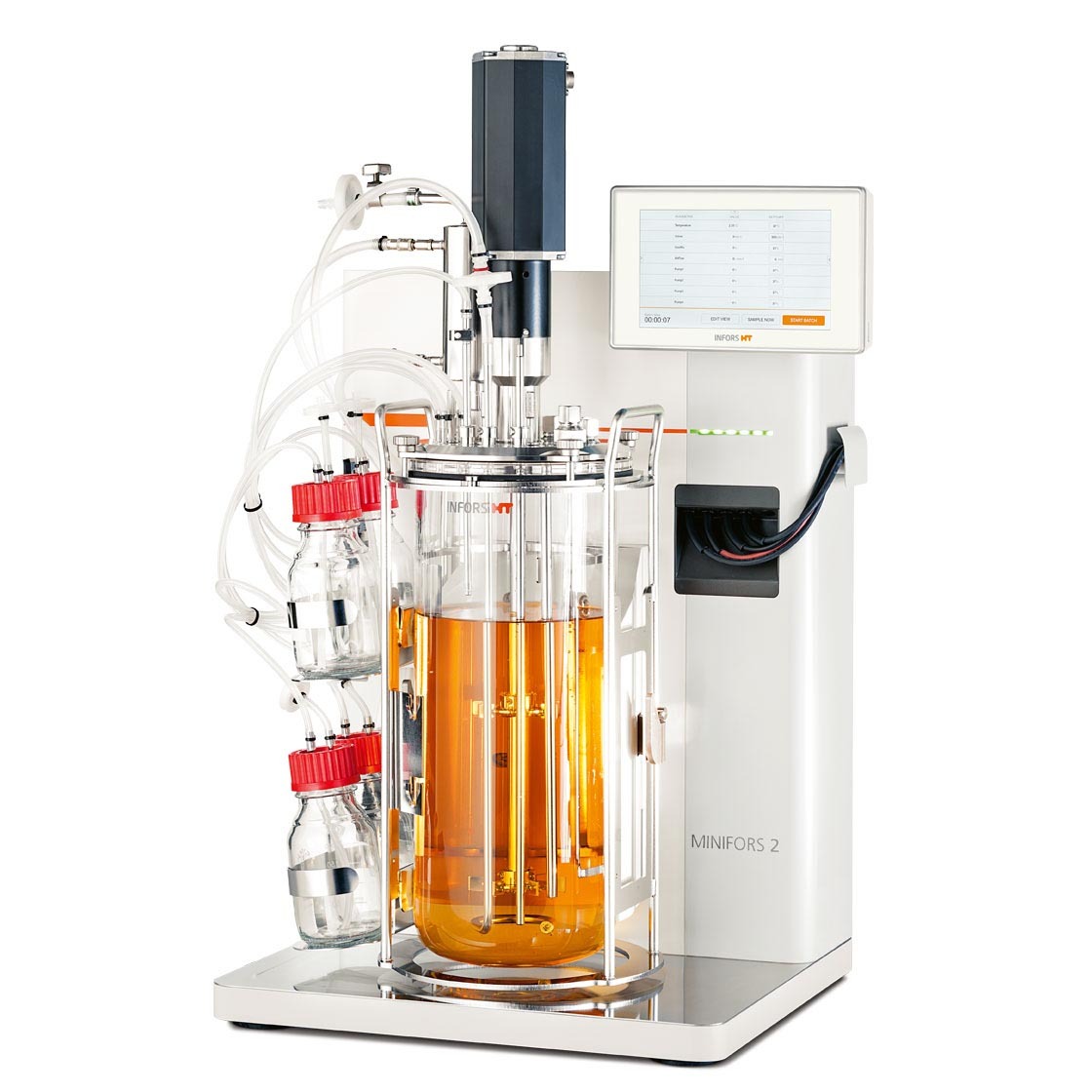
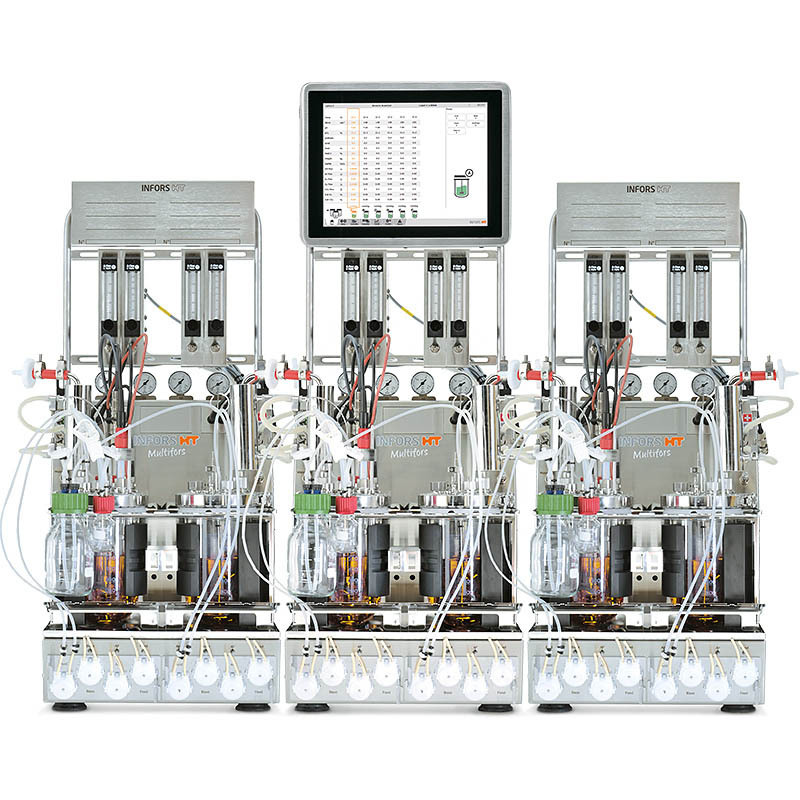
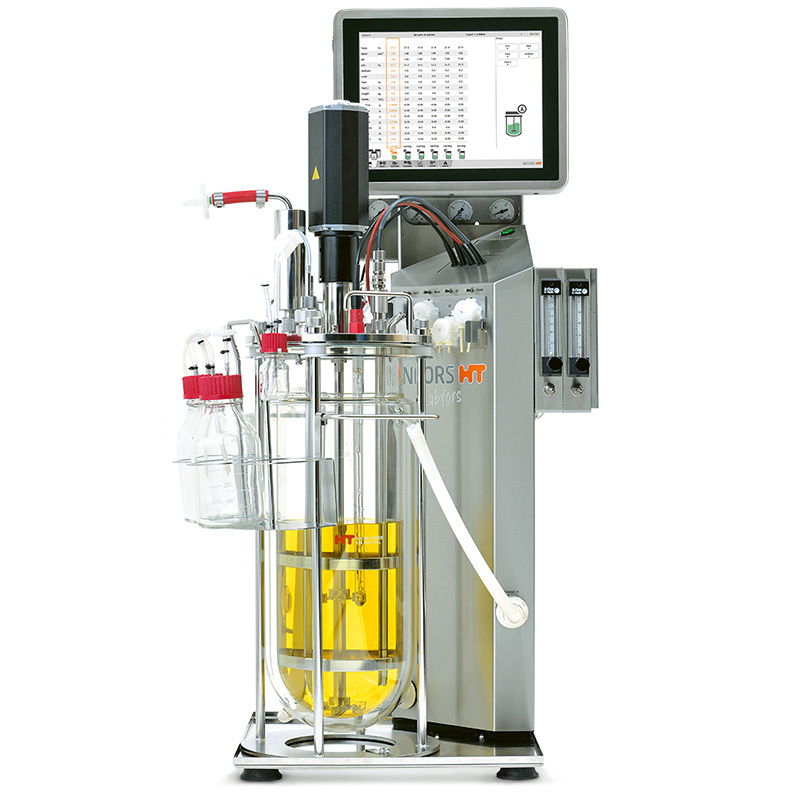
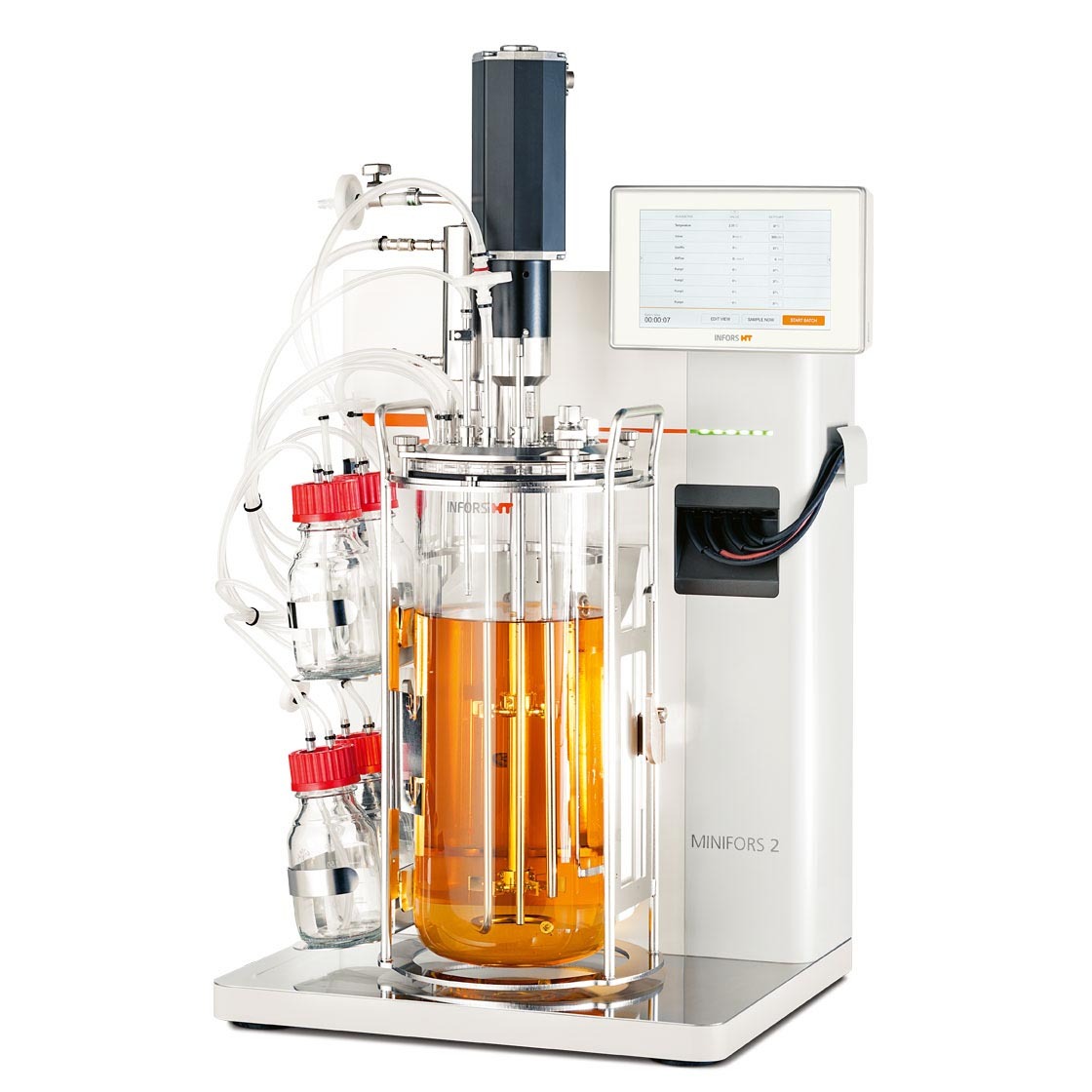
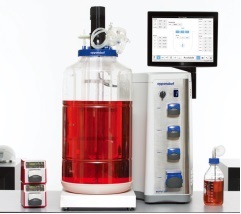
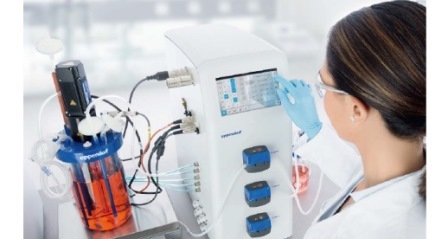
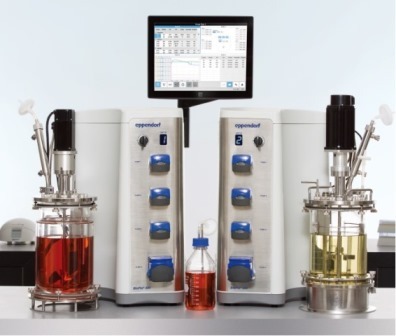

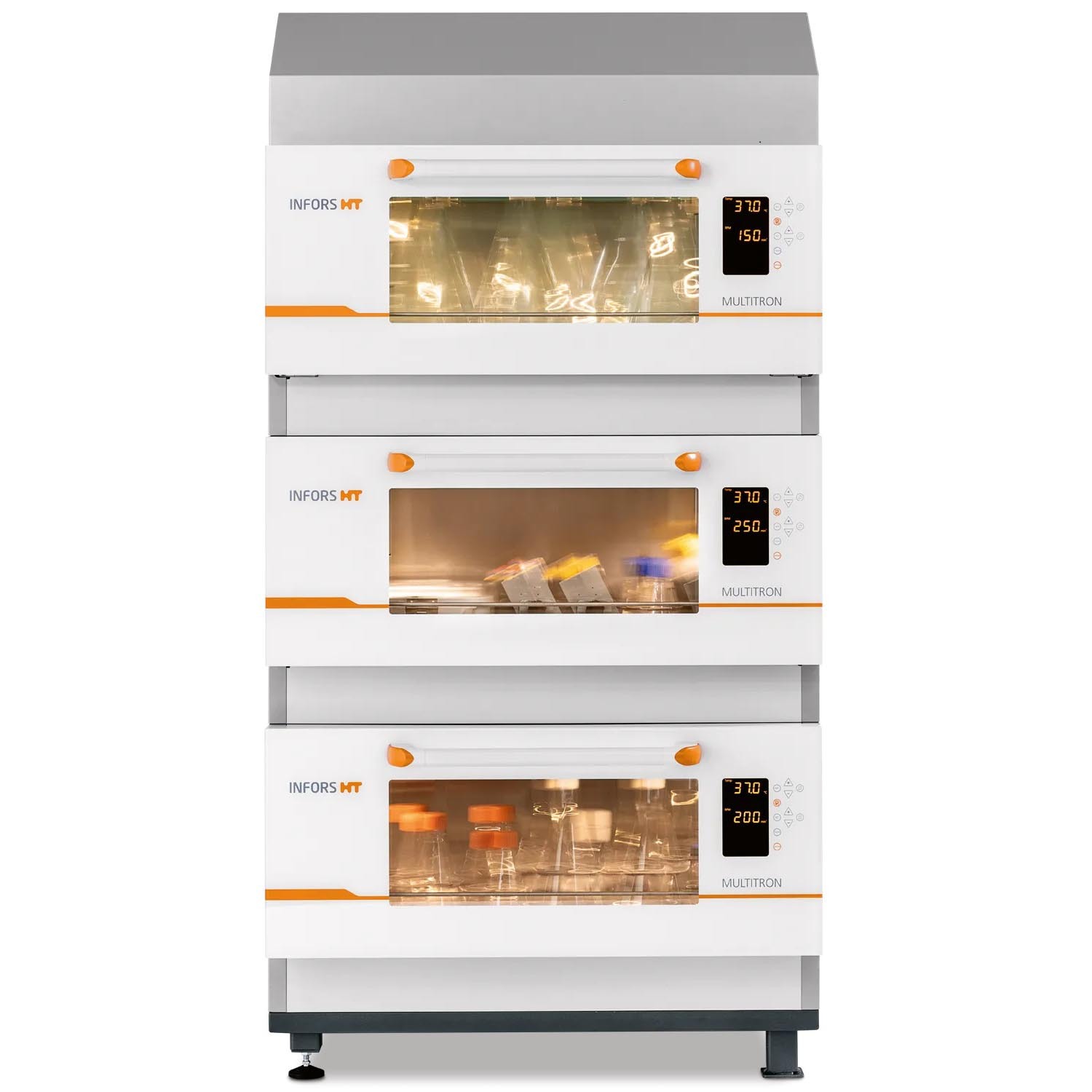
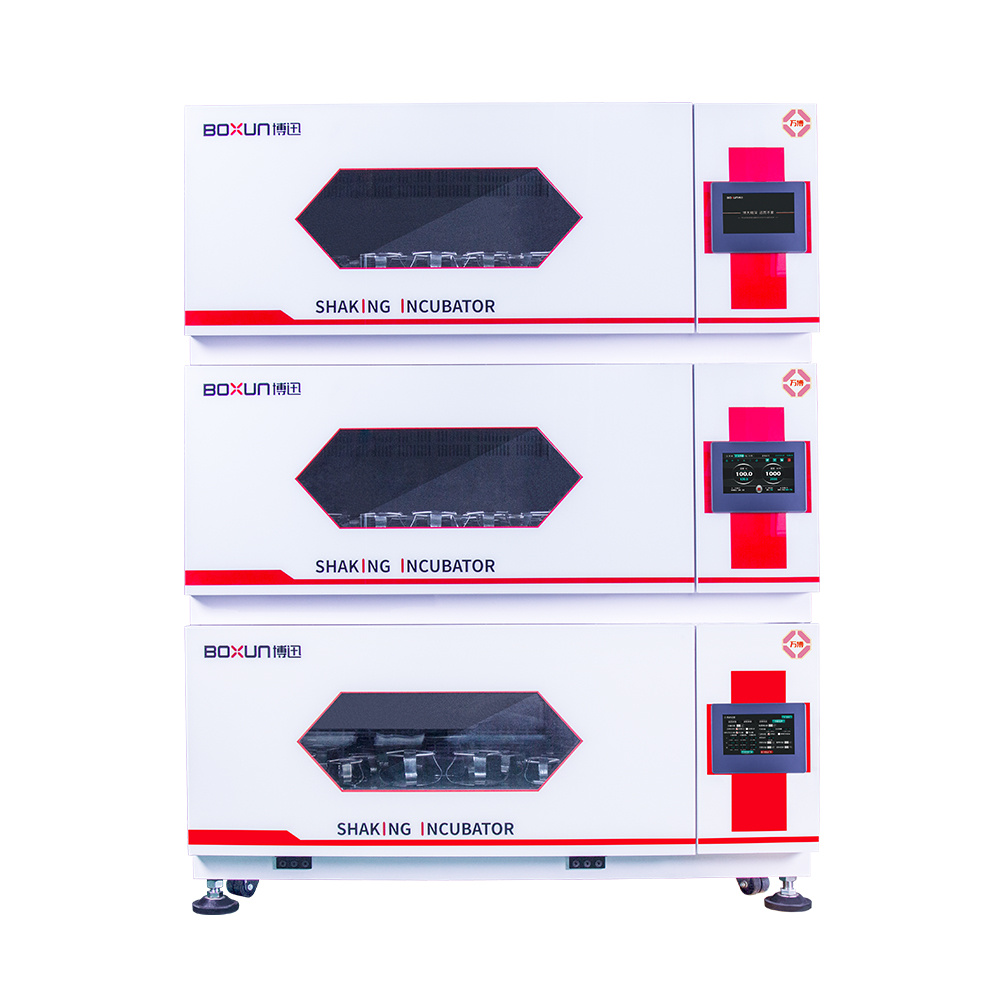
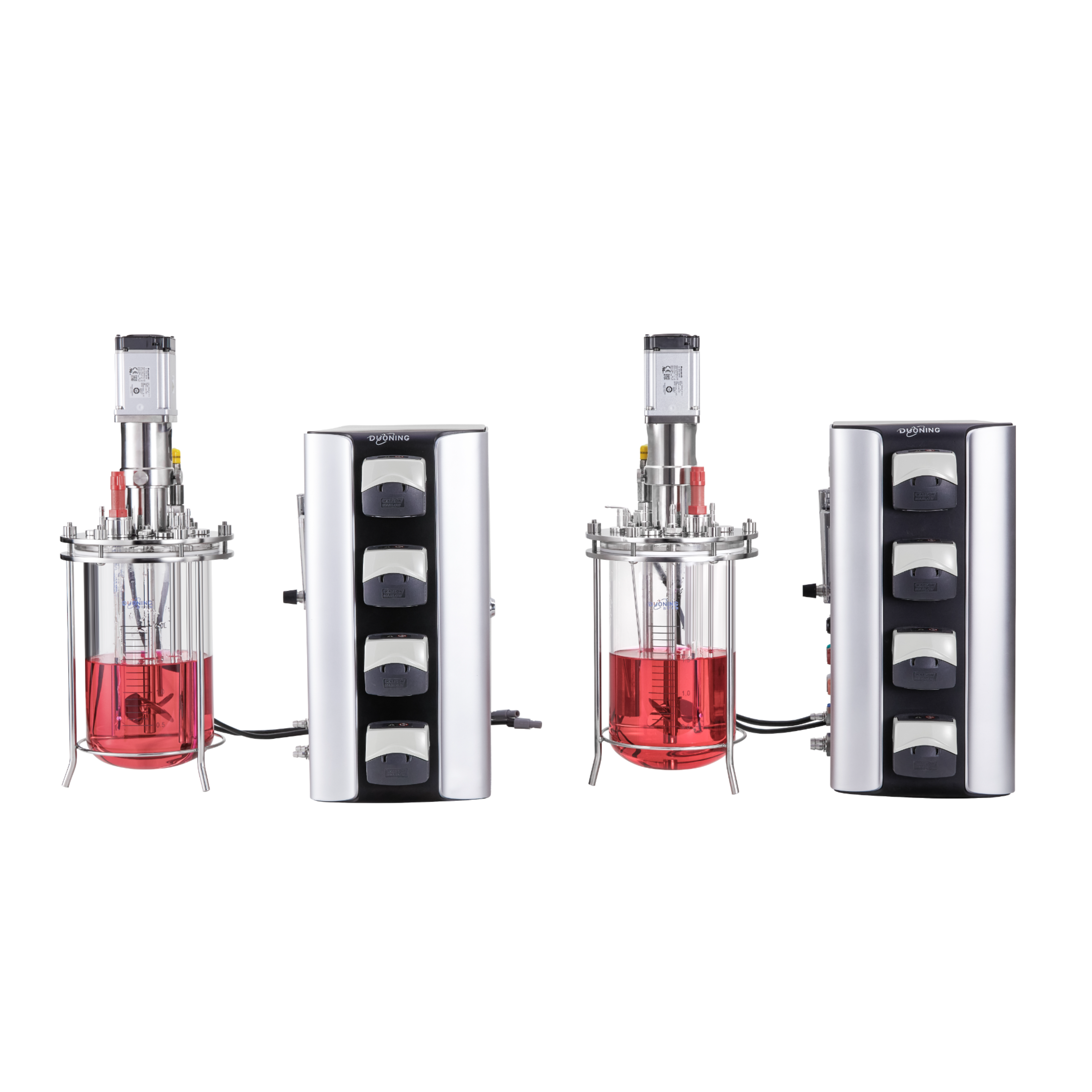
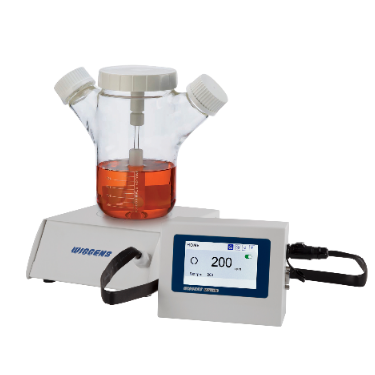

 咨询
咨询
